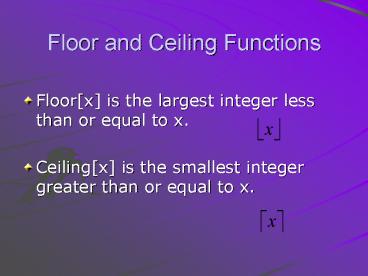Floor and Ceiling Functions PowerPoint PPT Presentation
1 / 17
Title: Floor and Ceiling Functions
1
Floor and Ceiling Functions
- Floorx is the largest integer less than or
equal to x. - Ceilingx is the smallest integer greater than
or equal to x.
2
Logarithms
- For bgt1 and xgt0, logbx (read log to the base b
of x) that is real number L such that bL x - logbx is the power to which b must be raised to
get x.
3
Logarithm properties
- def lg x log2 x ln x loge x
- Let x and y be arbitrary positive real numbers,
and let bgt1 and cgt1 be real numbers. - logb is a strictly increasing function, if x gt y
then logb x gt logb y - logb is a one-to-one function, if logb x logb
y then x y - logb 1 0 logb b 1 logb xa a logb x
- logb(xy) logb x logb y
- xlog y ylog x
- change base logcx (logb x)/(logb c)
4
Series
- A series is the sum of a sequence.
- Arithmetic series
- The sum of consecutive integers
- Polynomial Series
- The sum of squares
- The general case is sum of
- numbers raised to
- the power of k
5
Series
- Powers of 2
- Arithmetic Geometric Series
6
Summations Using Integration
- If f(x) is nondecreasing then
- If f(x) is nonincreasing then
7
Monotonic Functions
- A function f(x) is said to be monotonic, or
nondecreasing, or increasing in wider sense if x
? y always implies that f(x) ? f(y). - A function f(x) is antimonotonic, or
nonincreasing, if f(x) is monotonic.
8
Asymptotic Growth Rates
- asymptotic growth rate, asymptotic order, or
order of functions - Comparing and classifying functions that ignores
constant factors and small inputs. - The Sets big oh O(g), big theta ?(g), big omega
?(g)
9
Classifying functions by theirAsymptotic Growth
Rates
?(g) functions that grow at least as fast as g
?(g) functions that grow at the same rate as g
O(g) functions that grow no faster as g
10
The Sets O(g), ?(g), ?(g)
- Let g and f be functions from the nonnegative
integers into the positive real numbers - For some real constant c gt 0 and some
nonnegative integer constant n0 - O(g) is the set of functions f, such
that f(n) ? c g(n) for all n ? n0 - O(g) f ? ?c ?n0 f(n) ? c g(n) for all n ?
n0
11
?(g), ?(g)
- ?(g) is the set of functions f, such that
- f(n) ? c g(n) for all n ? n0
- ?(g) O(g) ? ?(g)
- asymptotic order of g
- f ??(g) read as f is asymptotic order g or f
is order g
12
Comparing asymptotic growth rates
- Comparing f(n) and g(n) as n approaches infinity,
13
Limit
- lt ?, including the case in which the limit is 0
then f ?O(g) - gt 0, including the case in which the limit is ?
then f ? ?(g) - c and 0 lt c lt ? then f ? ?(g)
- 0 then f ? o(g) //read as little oh of g
- ? then f ? ?(g) //read as little omega of g
14
Properties of O(g), ?(g), ?(g)
- Transitive If f ?O(g) and g ?O(h), then f
?O(h).O is transitive. Also ?, ?, o, ? are
transitive. - Reflexive f ? ?(f)
- Symmetric If f ? ?(g), then g ? ?(f)
15
?
- ? defines an equivalence relation on the
functions. - Each set ?(f) is an equivalence class (complexity
class). - f ?O(g) ? g ? ?(f)
- O(f g) O(max(f, g)) similar equations hold
for ? and ?
16
Classification of functions
- lg n ? o(n?) for any ? gt 0, including fractional
powers - nk ? o(cn) for any k gt 0 and any c gt 1
- powers of n grow more slowly than any
exponential function cn
17
Classification of functions
- O(1) denotes the set of functions bounded by a
constant (for large n) - f ? ?(n), f is linear
- f ? ?(n2), f is quadratic f ? ?(n3), f is cubic

